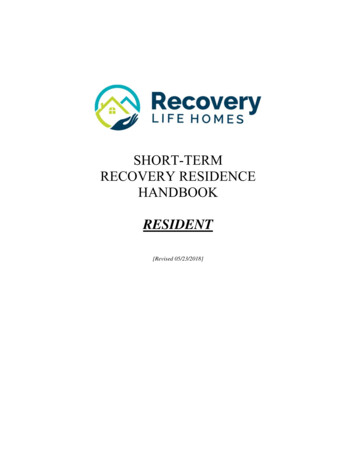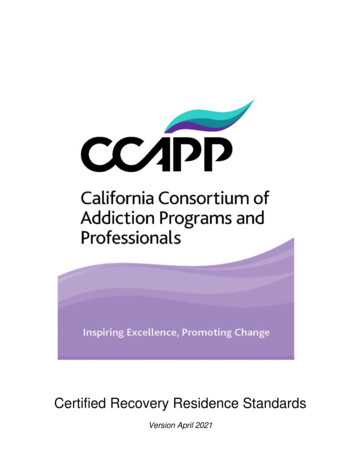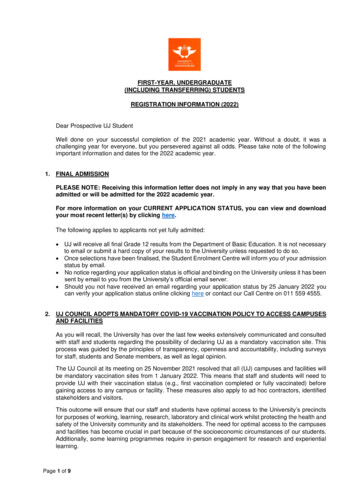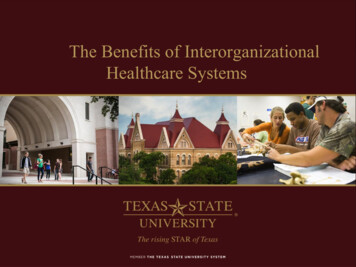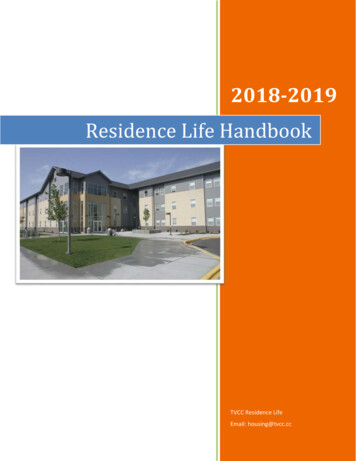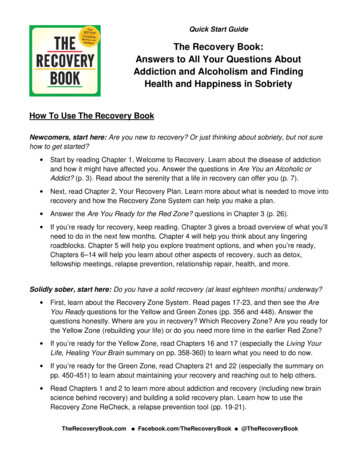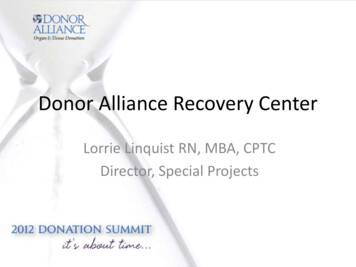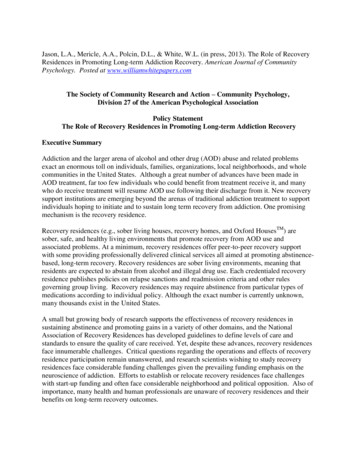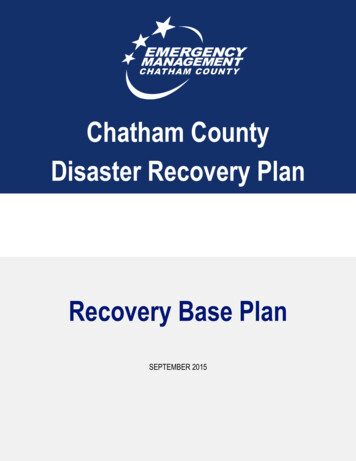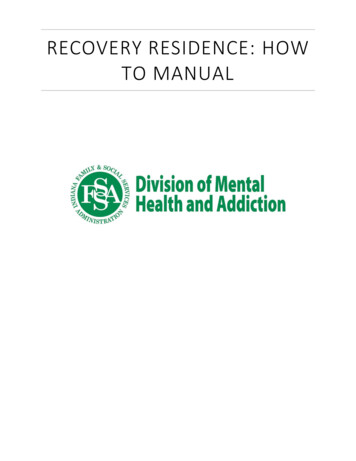
Transcription
RECOVERY RESIDENCE: HOWTO MANUAL
Dear Future Landlord,Half-way house. Transitional living. Sober home. These are all alternative terms for RecoveryResidence. They are probably the terms that you may be more familiar with or have heardbefore. In an effort to unify and encompass all the terms being used to define the same servicesbeing provided, the National Alliance of Recovery Residences coined the term “RecoveryResidence”. It helps to not only make sure that all service providers are on the same page, but italso accurately describes the residential modality of recovery support. At a bare minimum,recovery housing and peer supports are the services that are provided by recovery residences.This manual was commissioned by the Indiana Family and Social Services AdministrationDivision of Mental Health and Addiction as a “how to” guide to assist you through the processof becoming a Recovery Residence. It is intended to be used as a point of reference as younavigate through the process of establishing your residence. Whether you already own aproperty that you want to transition into a Recovery Residence, or you are at the “thinkingabout it” stage, this manual is designed to help and support you along the way. It isrecommended that your organization team members who are responsible for working on theRecovery Residence program development read this manual in its entirety prior to initiating thisprocess. There is a considerable amount of information that is shared which provides importantsteps to more effectively and efficiently guide your team in the development of your residence.Most importantly, these suggestions and recommendations were obtained through conductingfocus groups with directors and staff of current recovery residences throughout the state. Theyhave offered their guidance and expertise with creating a recovery residence to ease thisprocess so that it is more successful for your organization. The manual does not give all of theanswers, but it will ask many questions, which will allow you the opportunity to explore howyou want to operate your residence. Remember, this is your organization and your residence.We wish you the best in your endeavors.This manual was created by Blanc Consulting Group on behalf of the Division of Mental Healthand Addiction.2 Page
Table of ContentsDear Future Landlord . 2How to Get started . 5Laying the Foundation . 6Establish a Budget . 6Identify Funding Opportunities. 7Build a Board of Directors . 7Find a Location . 9We Have the Property – What is Next? . 11Home Repairs . 11Americans with Disabilities Act . 12Insurance. 12Networking. 12Neighbor Relations. 14Development . 15Who are you? Mission and Vision . 15Policies and Procedures . 16Process and certifications . 20State, City, and County Certification Processes. 21State . 21City/County . 21Indiana Affiliation of Recovery Residences . 21Department of Mental Health and Addiction . 23Recovery Works . 25Before You Open . 26Establish Paperwork . 27Hire and Train Staff . 283 Page
Hire . 28Staff Development . 29Billing Process . 30Referral Relationships and Processes . 30Ongoing Process and Management . 32Household Management – Level II – IV . 33Data Collection. 34Working with Others . 34Working with the State . 35Appendix and Resources . 37Appendix . 38Resources . 39References . 39Additional Website Resources . 394 Page
HOW TO GET STARTED5 Page
Laying the FoundationEstablish a BudgetWhile your motivation or mission may be different from a for-profit business, you still need tounderstand your income and expenses in order to be successful. Since you may have no pastinformation to go on, a budget must be created using your best estimates. Some things to thinkabout before you begin: Have you reached out to the Indiana Affiliation of Recovery Residences for technicalassistance opportunities?What do you need to open the door on the first day?What will your fixed costs be on a continuing basis? (e.g. staff, mortgage/rent, utilities,etc.)What will your variable costs be on a continuing basis? (e.g. client “rent”)What can you contribute to keep costs low? (e.g. furniture)What can you get as donations? (e.g. toiletries, food)What can you do without? (e.g. decorations)Start by thinking about what will be needed on day one, in order to open the doors of yourRecovery Residence. This can typically be broken down into four categories: facility costs(house), fixed assets (capital costs such as furniture), materials and supplies (e.g. office supplies,marketing), and other costs (license, permits, consultants fees, etc.). The next step will be toestablish the monthly expenses and consider those costs that typically do not change frommonth to month (mortgage/rent, utilities, phone, insurance, employee costs, etc.).Lastly, you will want to estimate your monthly income. It is vital that you are realistic here. Forexample, you most likely will not be at capacity from day one. This means that you will not becollecting rent from residents 365 days of the year. Your budget will be your guide during yourfirst year. A sample budget has been included in the Appendix to provide an example of thisprocess.The following areas should be considered when developing a budget:1. You will note that there are start-up costs in the budget. This is all the funding that willbe necessary to open the doors of the Recovery Residence. You will need to have thesecosts included in your budget.2. This budget example is for a 12-bed Recovery Residence. In the Income section, pleasenote that the budget does not start with all 12 beds occupied. There is a ramp up6 Page
period. All beds are not full until month four. It is recommended to be conservative withyour estimates, not only regarding your program, but also with your budget.3. Lastly, it is strongly recommended that you open doors with a reserve large enough tooperate for no less than two years. This will safeguard you against unexpected costs andemergencies, allow the Recovery Residence to operate without relying on income fromresidents, and help to ensure longevity of your business. Please note that on the samplebudget the expenditures will exceed the income for the first several months, so havingthe reserve will help defray these “start-up costs”.Identify Funding OpportunitiesThe organization is getting ready to address a basic need for individuals who are at a vulnerablepoint in their recovery. Typically, individuals enter a Recovery Residence early in their recovery.Residents are still learning about recovery and are re-learning life without substances. Byproviding some basic needs for them such as shelter, food, and a safe place, they can focus ontheir recovery. These services need to be provided for the residents for the foreseeable future;therefore, it is very important to consider the recommendation that funding be developed andsecured for at least two years.The organization may consider a variety of options for funding the residence for this initial twoyear period. These could include, but not be limited to: Financial Institution LoansAccessing board member or key stakeholder assistanceDonations/fundraisersCorporate sponsorshipBuild a Board of DirectorsHaving a board of directors is a best practice for any business, regardless of the size or for-profitor non-profit status. Boards are the businesses backbone for growth. They are the people thathelp to advise you on the best way to create and manage a quality Recovery Residence. Theboard can help you develop ideas for growing the business, managing client/residentsatisfaction and best practices with the Recovery Community. Lastly, boards provide someaccountability to the management team within the business.Bo Ilsoe, with Nokia Growth Partners, a global venture capital firm, has spent more than 30years in operations and investments. Along the way, he has had the opportunity to learn a thingor two about what an effective, well-run board looks like. He shares in a blog post on7 Page
VentureBeat, that “building a board is incredibly challenging, yet getting it right is critical tosetting the tone for success from the start” (Ilsoe, 2017). In his post, he shares eight steps tobuilding a strong board of directors. Below is a summary of those steps.1. Look beyond your investors: You must remember that an investor does notautomatically deserve a board seat. Often times, individuals or companies that invest inorganizations/agencies do so for their own specific interest or agenda. That interest oragenda may not match with the agenda or interest of the organization, which canultimately detract from, rather than add value to, a board. Bo also notes that,“(S)imilarly, while the founder is an integral part of the team, he/she is not always thebest fit for a board seat” (Ilsoe, 2017).2. To help set the stage from the top, find a board president with experience; one whohas been there before: Bo notes that choosing a board president based on non-boardwork experience is a mistake. He recommends that the person should have five to 10years of experience working on a board and must be able to manage diversestakeholders, both internally and externally. Additionally, a board president should playthe role of coach or mentor to the CEO/Executive Director. They should be able toredirect by suggesting corrective actions, assist with hiring, and fundraise. They shouldbe someone that augments the management team and helps them perform at higherlevel. The board’s president and CEO/Executive Director should never be the sameperson (Ilsoe, 2017).3. Be transparent and keep communication lines open: Be upfront about board changes.Keep dialogue with board members consistent, open, and truthful. Doing this willensure your board members are not blindsided when changes do occur. It ensurescontinued trust. This also applies in identifying new external candidates; make sure thatyou are including current members in the selection process.4. Board size: While the ideal board size varies, Ilsoe believes that the magic number is five, with a maximum of seven. He thinks that keeping the number small “ensures diversityof view while retaining discipline, focus, engagement and commitment” (Ilsoe, 2017).5. Plan for the long run: “The best boards have the right mix of skills, abilities, andperspectives, so think carefully and holistically about whom you choose for your board.Be particularly thoughtful in selecting your board president. The board president willplay a critical role in shaping your organization’s culture and guiding it along the path tosuccess. Also consider that you’ll likely work with each person for five to seven years —so make decisions with the long term in mind” (Ilsoe, 2017).6. Avoid applicants actively seeking board seats: “A good rule of thumb is to avoid peoplewho actively put themselves forward for board positions. These people are likely moreinterested in their own goals than in the goals and interests of your (organization). Yourbest choice is likely too busy to worry about their next board position, which meansyou’ll have to actively convince them to work with you” (Ilsoe, 2017).7. Set clear expectations to build trust: Putting the right team together is only the start.Now you have to make the board work, and make meetings functions, to your benefit.Transparency and clear communication are going to continue to be important here. Themantra of “Under promise, and over deliver” is a safe bet here. However, be careful of8 Page
selling yourself and the organization short. You have goals and expectations to meettoo. It’s also important to spend time together as a board outside of meetings. Makesure to cultivate relationships through an annual, full day strategy meeting andoccasional dinners or outings to bolster board morale (Ilsoe, 2017).8. Make meetings meaningful: Board meetings are often a drag. Yet the responsibilityultimately lies with you, as the CEO/Executive Director, to make sure they aresuccessful. You should come to the meeting with a “plan of action in place and beprepared to take charge, manage expectations, be demanding when needed, and staycandid about the good, the bad, and the ugly. Pre-meeting preparation is essential;ensure materials are distributed in advance and that board members have hadadequate time to review information and arrive at the meeting ready to discuss the realissues. While meeting cadence varies, I urge companies to take advantage of subcommittees and outside experts to address specific issues. This allows smaller groups tomeet more frequently to tackle particular matters of regulation, compensation,recruiting, lobbying, etc., and report back results to the CEO and board-at-large” (Ilsoe,2017).Building the right board takes time, patience and considerable effort. However, the outcomewill ultimately benefit your organization.Find a LocationNow that the budget and the board have been established it is time to find a residence. First, anorganization must consider zoning. All buildings, whether businesses or homes, are zoned for aparticular occupancy. For example, commercial properties, which house retail stores or offices,are generally zoned as a C-1 Property and cannot be used as residences without a specialpermit or variance. Zoning is controlled by local units of government, and because of this, thereare many different terms possible. Below are a few basic terms to note that will be helpfulwhen reviewing properties: R-1 Property: Generally, this designates a zoned area where only Single-FamilyResidences are allowed.R-2 Property: Generally, this designates an area where single family and 2 familyresidences are allowed. An example would be a duplex.R-3 Property: R-3 and higher generally provide for different levels of multi-familyresidences.C-1 Property: Commercial Property where retail, office and other similar commercialuses are allowed.C-2 Property: C-2 and higher designate varying degrees of commercial uses that providefor a more intense use of the land, such as garages, motor vehicle repair facilities, gasstations and the like. Reading the local zoning ordinance carefully is recommended todetermine the allowed uses.9 Page
I-1 Property: I-1 generally signifies a light industrial property. Often in a light industrialproperty commercial uses are allowed, along with light manufacturing. Lightmanufacturing designation allows plants that have a low impact on the surroundingarea. Light industrial uses generally do not allow for loud disturbing noises or noticeabledischarge of gases or fluids. Again, local ordinances should be carefully reviewed andconsidered.I-2 Property: I-2 and higher zoning classifications generally allow for more intense use ofthe property. These areas are reserved and promoted for manufacturing. These areasare necessary for jobs and productivity but having the recovery residence next to onemay not be desirable. Again, consult the local ordinance for the specific allowed uses.A Property: Agricultural Property is a growing zoning classification. In an agriculturalarea, zoning is now often used to try and preserve the farming character of the area.Agricultural zoning often requires very large lots for placement of a single home; forexample, up to 25 acres or more. There is a growing trend to use zoning to preserve theundeveloped parts of our country.PUD Property: This does not stand for any type of property in particular. PUD stands forPlanned Unit Development. A PUD zoning designation is especially created to allow adevelopment that does not fit into or comply with the requirements of the usual zoningclassifications. For example, condominium complexes are often Planned UnitDevelopments. The condominium will have a greater density of housing than allowed bynormal Residential Classes. If the developer convinces the local board that administersthe zoning ordinance that the development would benefit the community, then thedeveloper would be allowed to build the Planned Unit Development. It is possible tohave a PUD for residential, commercial (such as a shopping mall) or industrial (such asan industrial park) properties. Be sure to check and see if any PUDs are in the area beingconsidered, that might affect the value and enjoyment of the property and prospectiveresidence.Special Use Permit: Sometimes the local board will allow different uses than the stateduse(s) in a particular area. For example, a doctor’s office normally does not have hightraffic, noise or other nuisance features. Having the doctor’s office in a residential areapromotes the public good and does not harm the surrounding values, as well as adeveloper who may want to build an apartment complex into a commercial area. Thezoning classifications (R-1, R-2, C-1, C-2, I-1, I-2 and A) will often have allowed differentuses spelled out in the ordinance. Typically, these are allowed only if they enhance thearea and do not harm the value and use of surrounding properties.Zoning Variance: Sometimes a use is not contemplated by a zoning ordinance, but theuse would be of such value to the community that the local board administering thezoning will allow the use as a variance. Such a use could be a power plant placed in anotherwise agricultural/residential area. The uses are not specifically compatible, but thetax base would generate significant revenue for the local government so that the use isallowed for the common good. There are also variances that are less imposing on anarea but were simply not contemplated when the ordinance was adopted. (Porter &Bergman, 2005)10 P a g e
It is strongly recommended that a realtor be hired when looking for a residence. A realtor willonly show you properties that are already zoned to allow what you want to do. However, ifthere is already a property being considered, then an architect can help with navigating thelocal government requirements in requesting a special use permit or zoning variance ifnecessary. The location must be zoned correctly in order to pass a fire inspection by the localfire marshal (Please note that verification of a fire inspection is a required item by INARR andDMHA).It is not possible to specifically identify the exact local government agency that you need toreach out to in order to begin to navigate the zoning process for your property as this differsacross the state. It is best to start with the city/town government in the area of the recoveryresidence. The local zoning ordinances can be found within the city/town’s codes. TheAmerican Planning Association, Indiana Chapter can also be used as a resource. Their website iswww.indianaplanning.org. It is also difficult to estimate the amount of time or a cost associatedwith this process, as it will vary for each property. It is estimated that an architect’s time wouldbe anywhere from 100- 250.00/hr. Please note that written permission from the propertyowner to operate a Recovery Residence is necessary per INARR standards.We Have the Property – What is Next?Home RepairsA property has been obtained, but it may need some repairs in order to get ready forhabitation. Based on the skill level of organization staff, there are many things that can becompleted internally, such as painting and small repairs. However, if there are major repairsthat need to be done, such as tearing down walls or replacing floors, and the repairs are aboveor beyond the level of expertise of the staff, it is strongly recommended that professionals arehired to complete the repairs or renovations. Remember that people will be living here, and theresidence needs to be a safe environment for them. This is not the place to cut corners. Anorganization can potentially save expenses in other areas by requesting donations forfurnishings, paint and/or needed supplies. It is important to refer to INARR Standards, DMHAstandards, and the local zoning codes of the residence to ensure that standards are being metfor all repairs. As a reminder, the structural, electrical, gas, and plumbing repairs should only becompleted by certified workers.11 P a g e
Americans with Disabilities ActIt is recommended that an architect be consulted to determine if the residence is subject to theAmericans with Disabilities Act requirements. Every location and local government havedifferent zoning requirements and regulations. The requirements for the residence’s locationwill need to be followed. You can access basic information at www.ADA.gov, and learn moreabout the qualifications and changes needed to make to the residence in order to stay up tocode. Based on the law, reasonable accommodations must be made for persons withdisabilities. (Information and Technical Asistance on the Americans with Disabilities Act, n.d.)InsuranceLiability coverage and any other insurance appropriate for the level of care being provided willneed to be acquired. An insurance broker/agent will be able to assist with the best options forthe coverage needed. The level and type of insurance needed will be different for everyRecovery Residence and business.NetworkingAn important part of beginning any business, but particularly one which will rely on referrals, isnetworking. It is essential that the organization administration effectively market their missionand services to the community, as well as the Recovery Community (including other RecoveryResidences). The following are a few recommendations: In Indiana, every community has a Local Coordinating Council. Consider becoming amember of the local community’s LCC. You can find out more about the local LCC atwww.in.gov/cji.Each county has a Community Correction board. The board meets on a regular basis,and typically allows for presentations from community providers. This would be a goodopportunity for the organization to share its mission and to market the program.Create a presentation about the Recovery Residence and the services offered or howyour residence is structured and present to: probation, court, public defender’s office,and prosecutor’s office.In addition to establishing amicable relationships with criminal justice partners, it isrecommended to get to know the treatment and service providers in your area. The RecoveryHouse will be providing the lowest level of care unless the residence is a Level IV residence.Therefore, relationships will need to be established with other treatment providers in order to12 P a g e
refer residents when other community or treatment services are needed, as well as to marketand promote the residence. Some important services to consider accessing include: Case Management: A majority of the residents will have a lot going on when they firstarrive at the residence. Some will be there because they decided they wanted a changein their life, and that drugs/alcohol were no longer worth it. However, a majority willmost likely be there because they are under some form of supervision and they havenowhere else to go. One of the things they need help with is managing all the systemsthey are trying to navigate: court, probation/parole/community corrections, SUDservices, addressing health care, making doctor appointments, finding a doctor, findinga job the list could go on and on. Having a referral source to help them manage all ofthis is vital, particularly if what the individual requires is not part of the services offeredat the residence. Connect2Help 2-1-1 can always be utilized as a resource for locatingservices in the area. In addition, the residence can be listed as a source in 2-1-1.Detoxification: This will allow the organization to have a referral source in the event thatthere is a resident that (a) needs detoxification prior to entering the residence or (b)relapses while staying at the residence and needs assistance.Education: It is always a good idea to know the local GED resources to assist clients thatmay not have received their high school diploma. In addition, being able to assist ordirect clients in the right direction, should they want to pursue higher education, wouldbe recommended.Employment: It will be necessary for the residents to find employment early in their stayin order for them to pay for their received services, pending how the residence programis established. Therefore, having resources to assist the residents with locatingemployment will be critical. It is recommended that the staff develop a relationshipwith the local Workforce One office, as well as establish relationships with local businessowners. This could include businesses that hire on a regular basis and would be willingto take a chance on those individuals that reside in the residence.Faith-based Community: Many people have some sort of belief system. Therefore,having connections with the faith-based community will allow referrals to be made tothe local faith institutions. Additionally, a lot of faith-based organizations may haveresources available for the clients such as clothes or bus passes. They may also hold 12Step meetings in their locations.Food Pantries: Food Pantries are a great resource for clients to access if they are in needof food sources. One thing to remember: if Recovery Works funding is being utilized,the residence must purchase food for at least one meal per day, which means that freefood cannot be utilized for that meal. Please refer to the Recovery Works servicemanual for all guidelines.Medication Assisted Treatment – For some residents, medication assisted treatment istheir chosen path of recovery. It is important to be able to support all residents andtheir chosen recovery paths.Mental Health service: Some residents will require additional men
being provided, the National Alliance of Recovery Residences coined the term "Recovery Residence". It helps to not only make sure that all service providers are on the same page, but it also accurately describes the residential modality of recovery support. At a bare minimum,

